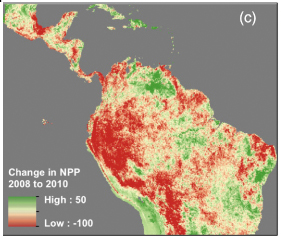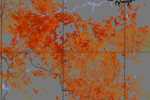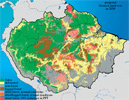
Amazon rainforest in Peru. Photo by Rhett A. Butler
The 2010 drought that affected much of the Amazon rainforest triggered the release of nearly 500 million tons of carbon (1.8 billion tons of carbon dioxide) into the atmosphere, or more than the total emissions from deforestation in the region over the period, estimates a new study published in the journal Environmental Research Letters.
Christopher Potter from NASA Ames Research Centre and colleagues combined a carbon cycle simulation model with NASA satellite data which reflects the ‘greenness’ or net primary production of forest to develop their estimate. The researchers only accounted for loss in CO2 uptake by vegetation caused by drought stress, including decomposition of soil and dead wood in regularly flooded forest areas left dry by the drought. Their estimate did not include emissions from fire associated with the drought.
Overall the researchers found emissions from the drought — the worst ever recorded in the Amazon — to be “roughly equivalent to the combined effects of anthropogenic deforestation and forest fires in undisturbed Amazonian forests.”

Regional map of annual net primary production anomalies derived from subtraction of the 2009 and 2010 from 2008 total NPP values from the CASA (Carnegie Ames Stanford Approach) simulation model. All carbon fluxes shown are in units of grams of carbon per square meter per year. Image courtesy of ERL. |
However Potter and colleagues said that some of the losses could be offset by increased plant growth with the resumption of normal conditions. Other studies showed such a recovery in the aftermath of the 2005 drought, which at the time had been the most severe on record.
Nevertheless other researchers fear that the apparent increase in severe droughts — believed to be a product of deforestation, fragmentation, and climate change — may portend a more dire scenario: collapse of the Amazon rainforest ecosystem.
Using simulation models that account for the impact of increased atmospheric carbon dioxide concentrations on temperature and precipitation in the region, scientists at the Hadley Center for Climate Prediction and Research in the UK have forecast significant “die-back” of the Amazon rain forest by mid-century and a virtual collapse of the ecosystem by 2100.
Meanwhile Dan Nepstad, a scientist at the Instituto de Pesquisa Ambiental da Amazônia (IPAM), has estimated that as much as 55 percent of Amazon forests could be “cleared, logged, damaged by drought, or burned” in the next 20 years should deforestation, forest fires, and climate trends continue apace. The damage will release 15-26 billion tons of carbon into the atmosphere, adding to a feedback cycle that will worsen both warming and forest degradation in the region.
CITATION: Christopher Potter, Steven Klooster, Cyrus Hiatt, Vanessa Genovese and Juan Carlos Castilla-Rubio. Changes in the carbon cycle of Amazon ecosystems during the 2010 drought. Environ. Res. Lett. 6 (July-September 2011) 034024 doi:10.1088/1748-9326/6/3/034024
Related articles
Amazon drought and forest fire prediction system devised
(07/18/2011) Researchers have devised a model to anticipate drought and forest fires in the Amazon rainforest.
NASA image reveals extent of 2010 Amazon drought
(04/17/2011) NASA has revealed a satellite image of the crippling effect of last year’s record-breaking drought on the Amazon ecosystem. For those of you counting, that’s two record droughts in the Amazon Basin in 5 years.
Last year’s drought hit Amazon hard: nearly a million square miles impacted

(03/29/2011) A new study on its way to being published shows that the Amazon rainforest suffered greatly from last year’s drought. Employing satellite data and supercomputing technology, researchers have found that the Amazon was likely hit harder by last year’s drought than a recent severe drought from 2005. The droughts have supported predictions by the Intergovernmental Panel on Climate Change’s (IPCC) that climate change, among other impacts, could push portions of the Amazon to grasslands, devastating the world’s greatest rainforest. “The greenness levels of Amazonian vegetation—a measure of its health—decreased dramatically over an area more than three and one-half times the size of Texas and did not recover to normal levels, even after the drought ended in late October 2010,” explains the study’s lead author Liang Xu of Boston University.
Two massive droughts evidence that climate change is ‘playing Russian roulette’ with Amazon
(02/03/2011) In 2005 the Amazon rainforest underwent a massive drought that was labeled a one-in-100 year event. The subsequent die-off of trees from the drought released 5 billion tons of CO2. Just five years later another major drought struck. The 2010 drought, which desiccated entire rivers, may have been even worse according to a new study in Science, adding on-the-ground evidence to fears that climate change may inevitably transform the world’s greatest rainforest.
NASA image reveals worst drought on record for the Amazon river
(12/15/2010) A new image released by NASA reveals the impact of the worst drought on record on the world’s largest river.
Amazon stores 10 billion tons of carbon in ‘dead wood’
(08/12/2009) Old growth forests in the Amazon store nearly 10 billion tons of carbon in dead trees and branches, a total greater than global annual emissions from fossil fuel combustion, according to scientists who have conducted the first pan-Amazon analysis of “necromass.”
Drought threatens the Amazon rainforest as a carbon sink

(03/05/2009) Drought in the Amazon is imperiling the rainforest ecosystem and global climate, reports new research published in Science. Analyzing the impact of the severe Amazon drought of 2005, a team of 68 researchers across 13 countries found evidence that rainfall-starved tropical forests lose massive amounts of carbon due to reduced plant growth and dying trees. The 2005 drought — triggered by warming in the tropical North Atlantic rather than el Niño — resulted in a net flux of 5 billion tons of carbon dioxide (CO2) into the atmosphere — more than the combined annual emissions of Japan and Europe — relative to normal years when the Amazon is a net sink for 2 billion tons of CO2.
Half the Amazon rainforest will be lost within 20 years

(02/27/2008) More than half the Amazon rainforest will be damaged or destroyed within 20 years if deforestation, forest fires, and climate trends continue apace, warns a study published in Philosophical Transactions of the Royal Society B. Reviewing recent trends in economic, ecological and climatic processes in Amazonia, Daniel Nepstad and colleagues forecast that 55 percent of Amazon forests will be “cleared, logged, damaged by drought, or burned” in the next 20 years. The damage will release 15-26 billion tons of carbon into the atmosphere, adding to a feedback cycle that will worsen both warming and forest degradation in the region. While the projections are bleak, the authors are hopeful that emerging trends could reduce the likelihood of a near-term die-back. These include the growing concern in commodity markets on the environmental performance of ranchers and farmers; greater investment in fire control mechanisms among owners of fire-sensitive investments; emergence of a carbon market for forest-based offsets; and the establishment of protected areas in regions where development is fast-expanding.














